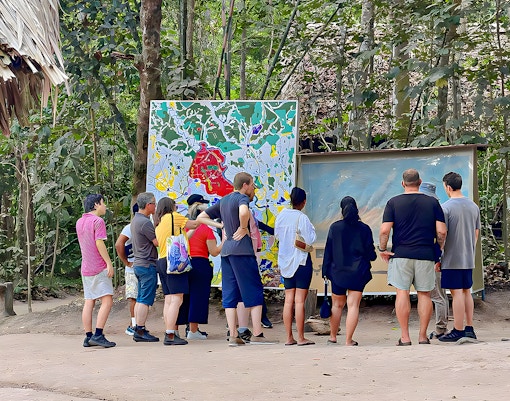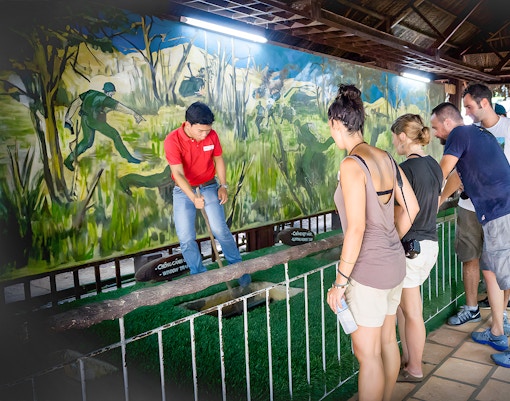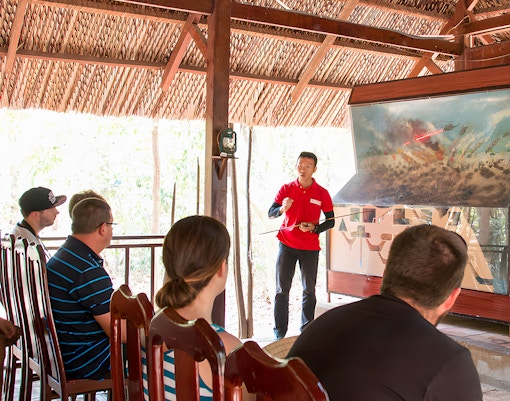The Cu Chi Tunnels were first dug by local villagers during the First Indochina War as small hideouts and supply routes against French colonial forces.
Beneath the quiet landscapes outside Ho Chi Minh City lies a secret world that once played a crucial role in Vietnam’s wartime history — the Cu Chi Tunnels. This intricate 120-kilometer network of underground passages served as homes, command centers, hospitals, and supply routes for Viet Cong soldiers during the Vietnam War. Today, it offers a fascinating glimpse into the strength, strategy, and survival that defined one of Vietnam’s most extraordinary chapters. Scroll down to explore the tunnels’ timeline, life underground, and more.
Tiny chambers carved from clay served as sleeping areas, hospitals, and meeting rooms, cramped but cleverly ventilated.
“Hoang Cam” kitchens dispersed smoke through long vents, allowing soldiers to cook rice without revealing their location.
Narrow passageways connected command centers, enabling Viet Cong fighters to coordinate surprise attacks and retreats undetected.
Soldiers worked, studied, and repaired weapons underground, emerging only at night to collect supplies or scout enemy activity.
Boiled cassava and tea sustained fighters for days; they relied on nearby forests and farms for occasional fresh food.
Camouflaged trapdoors, hidden vents, and booby traps protected the tunnels from enemy intrusion. When U.S. “tunnel rats” entered, the Viet Cong used their knowledge of the maze to outsmart them.
The Cu Chi tunnel network stretched over 250 km from Saigon to the Cambodian border, forming a secret lifeline for troop movement, supply routes, and intelligence exchange.
This underground fortress housed command centers, hospitals, and weapon workshops, allowing thousands of soldiers to live and fight without surfacing for months.
Built in hard red clay soil, the tunnels were resistant to collapse, equipped with air vents, trapdoors, and smoke-dispersal stoves that made detection nearly impossible.
By exploiting U.S. reliance on superior firepower, the Viet Cong turned the terrain into a weapon, striking suddenly and disappearing underground before retaliation.
The proximity to Saigon made Cu Chi the launch point for major operations, including assaults during the Tet Offensive, amplifying its wartime significance.
Strategically located in the III Corps zone, Cu Chi’s soil composition and dense forests provided ideal natural camouflage for tunnel entrances.




The tunnels were built on three levels, ranging from 3 to 10 meters deep, designed to withstand bombings and flooding.
No, some were simple passageways, while others were complex with meeting rooms, weapon workshops, and medical units. The Ben Duoc area housed larger, more authentic tunnels than Ben Dinh.
Entrances were camouflaged under leaves, with tiny wooden trapdoors blending perfectly into the forest floor. Even experienced soldiers often couldn’t detect them.
After 1975, the tunnels were preserved as a war memorial. Sections were reinforced and opened for visitors to educate future generations.
The tunnels were dug in laterite clay soil, naturally hard and stable, a key reason they could withstand bombings without collapsing.
They used whisper codes, hand signals, and hidden ventilation holes to transmit sound. Some tunnels even had echo chambers to detect intruders.
Some parts of the original system remain accessible, but most tunnels open to tourists have been widened and stabilized for safety and comfort.
Yes. Many female fighters and medics lived and worked in the tunnels, handling communication, nursing, and supplies.
Yes! You can visit weapon displays, trap replicas, and the shooting range, and try cassava with peanut salt, a wartime staple.
Cu Chi Tunnels Half-Day Guided Tour - Private Group
Cu Chi Tunnels Half-Day Guided Tour with Hotel Transfers- Join-In
Cu Chi Tunnels & Mekong Delta Full Day Tour
Cu Chi Tunnels & Ho Chi Minh City Full-Day Tour